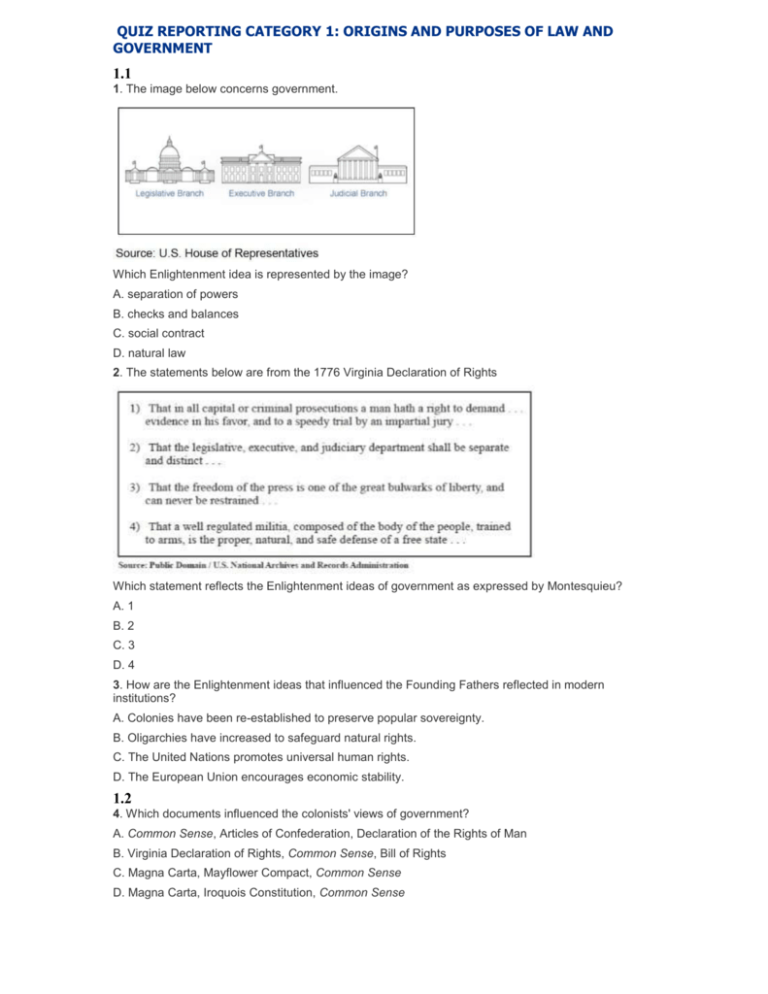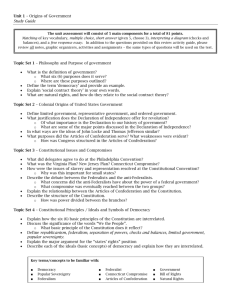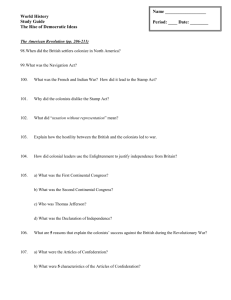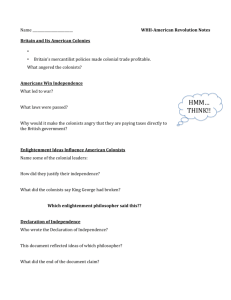quiz reporting category 1: origins and purposes of law and government
advertisement

QUIZ REPORTING CATEGORY 1: ORIGINS AND PURPOSES OF LAW AND GOVERNMENT 1.1 1. The image below concerns government. Which Enlightenment idea is represented by the image? A. separation of powers B. checks and balances C. social contract D. natural law 2. The statements below are from the 1776 Virginia Declaration of Rights Which statement reflects the Enlightenment ideas of government as expressed by Montesquieu? A. 1 B. 2 C. 3 D. 4 3. How are the Enlightenment ideas that influenced the Founding Fathers reflected in modern institutions? A. Colonies have been re-established to preserve popular sovereignty. B. Oligarchies have increased to safeguard natural rights. C. The United Nations promotes universal human rights. D. The European Union encourages economic stability. 1.2 4. Which documents influenced the colonists' views of government? A. Common Sense, Articles of Confederation, Declaration of the Rights of Man B. Virginia Declaration of Rights, Common Sense, Bill of Rights C. Magna Carta, Mayflower Compact, Common Sense D. Magna Carta, Iroquois Constitution, Common Sense 5. The diagram below shows that the colonists formed some of their political views from some historical documents. Which phrase completes the diagram? A. separation of powers B. economic freedom C. self-government D. individual rights 6. The passage below was written by Thomas Paine in his 1776 pamphlet, Common Sense. Based on this passage, how is the author's view reflected in the U.S. political system? A. The monarchy creates limited government. B. The monarchy supports self-government. C. Representatives are appointed. D. Representatives are elected. 1.3 7. Which documents addressed colonial concerns about English policies? A. Declaration of Independence B. Mayflower Compact C. U.S. Constitution D. Bill of Rights 8. The diagram below describes a cause that led to the writing of the Declaration of Independence. Which action completes the diagram? A. Colonial agriculture trade increases. B. Colonial religious devotion increases. C. Colonial demand for political change increases. D. Colonial demand for military assistance increases. 9. Why did Parliament eventually repeal the Stamp Act, which taxed goods such as newspapers and playing cards? A. The colonists established a blockade against British goods. B. The colonists were able to produce their own goods. C. The colonists started destroying British goods. D. The colonists began boycotting British goods. 1.4 10. The passage below is from a historical document. Which document contains this passage? A. Declaration of Independence B. Articles of Confederation C. English Bill of Rights D. U.S. Constitution 11. The passage below was written by Thomas Paine in his 1776 book, Common Sense. Based on this passage, with which complaint against the king from the Declaration of Independence would Thomas Paine agree? A. persecuting immigrant groups B. taking away religious rights C. taking away political rights D. persecuting racial groups 12. What is one way that the ideas stated in the Declaration of Independence are evident today? A. equal employment opportunities B. voting rights amendments C. selective service D. term limits 1.5 13. The diagram below shows steps leading to a historical event. Which event completes the diagram? A. Declaration of Independence B. Articles of Confederation C. Annapolis Convention D. Whiskey Rebellion 14. How did the U.S. Constitution solve a problem created by the Articles of Confederation? A. It avoided the issue of states' rights. B. It allowed the states to elect representatives. C. It prevented the amendment of federal laws. D. It enabled the federal government to collect taxes. 15. The passage below is from a historical document. How does the U.S. Constitution address concerns that resulted from the government described in this passage? A. The new government could enforce treaties between the states. B. The new government could settle disputes between the states. C. The new government could regulate trade between the states. D. The new government could levy taxes between the states 1.6 16. Which part of the U.S. Constitution states the six purposes of government? A. Bill of Rights B. Article IV C. Preamble D. Article I 17. In the Preamble to the U.S. Constitution, what is the meaning of the phrase "We the People"? A. The people express their will through political parties. B. The people express their will by directly creating laws. C. Government receives taxes from the people and exists to support them. D. Government receives its power from the people and exists to serve them. 18. The statement below is from a historical document. How is this statement reflected in the modern American political system? A. Voters elect Congress members. B. The Electoral College elects Congress. C. Congress enforces policies. D. The president enacts policies. 1.7 19. What check does the U.S. Senate have on the president? A. overriding vetoes B. appointing judges C. declaring laws unconstitutional D. refusing to confirms appointments 20. The passage below is from Federalist No. 47, written by James Madison in 1788. Based on this passage, which constitutional principle does Madison describe? A. separation of powers B. checks and balances C. popular sovereignty D. judicial review 21. Which principle supports President Eisenhower's action to uphold the U.S. Supreme Court's decision that public schools should be integrated? A. judicial review B. checks and balances C. separation of powers D. constitutional government 1.8 22. What was the Anti-Federalists' greatest concern about ratifying the U.S. Constitution? A. The lack of a federal court system. B. The lack of legislative veto power. C. The lack of a strong military. D. The lack of a bill of rights. 23. Which statement supports the Anti-Federalists in the struggle over ratification of the U.S. Constitution? A. The Constitution should limit state government. B. The Constitution should protect fundamental rights. C. The Constitution should create a strong national government. D. The Constitution should prevent the election of amateur politicians. 24. The passage below was written by James Madison in 1787. Based on this passage, what change in modern political society would Madison support? A. Expanding the size of the Cabinet B. Expanding the size of the Electoral College C. Expanding the number of candidates in campaigns D. Expanding the role of special interest groups in campaigns 1.9 25. Which principle is included in the U.S. Constitution? A. rule of law B. right to trial C. capitalism D. confederalism 26. Which statement describes an impact of the rule of law? A. state of nature B. checks and balances C. separation of powers D. transparency of institutions 27. Which characteristic serves as a long-term protection against tyranny and is a foundation of liberty in the United States? A. the commerce clause B. the elastic clause C. the right to trial D. the rule of law 3.10 28. The Code of Hammurabi (1772 BC) includes laws focusing on contracts. What type of U.S. law is based on the Code of Hammurabi? A. civil B. constitutional C. criminal D. military 29. Which type of law is used to help solve disputes between people or organizations? A. civil B. constitutional C. criminal D. military 30. The passage below is from a U.S. Supreme Court opinion announcement. According to the passage, which action did the U.S. Supreme Court find constitutional? A. The death penalty may be imposed only on adults. B. The death penalty may be imposed only on juveniles. C. The death penalty may be imposed on both adults and juveniles. D. The death penalty may be imposed on neither adults nor juveniles. ANSWER KEY 1. a 2. b 3. c 4. c 5. c 6. d 7. a 8. c 9. d 10. a 11. c 12. a 13. b 14. d 15. b 16. c 17. d 18. a 19. d 20. b 21. d 22. d 23. b 24. d 25. a 26. d 27. d 28. a 29. a 30. a








